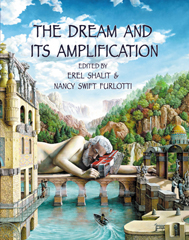Serena Carroll reviews The Dream and Its Amplification
"Amplification of Dreams" is not a light book, but one rich in its variety of earnest expression. These fourteen authors assemble their wisdom and experience under one great umbrella. They reach down into their depths to bring personal insights about the mind's (or psyche's), dream capacity -- or you may say, the amplification thereof. Every chapter is different, rich and interesting and very different in each author's approach. It's a book to keep nearby, pick up and read over parts again, as I have been doing, and enjoying it more as I do so.
What stands out for me? To mention a few:
Isler's Alpine Dreams making their way into the regions centuries old fairy tales, Wikman's own near death experience embodied as a dream, Swift-Furlotti's dream wherein an actual snake ritual and initiation, or new birth, takes place. Snakes, which are probably the oldest recognized key dream image around, come up again in Singer's heart touching story.
Abramovitch's attitudes on Jewish dream work from early Talmudic times, is similar to the 6th century Ancient Greeks, in the Temple of Asclepius, where seekers sought the priests' counsel in the dream abaton or temple.
If you're a thinking type you may respond one way, a feeling type, then you'll have another reaction.
Gilda Franz writes with all her heart in 'Dreams and Sudden Death' and gives us some practical advice on how to delve into and amplify one's dream.
Dream work is not new, Jung just expanded upon it greatly for our present era and in doing so brought a whole new dimension to the science and art of psychology.
These fourteen scholars manage to bring all of their wisdom and experience under one tent. I wish I had had this book in psych grad school 18 years ago, so much would have been made clear, although one does not need to be an academic to appreciate its scope and depth.
Serena Carroll is a trained therapist, astrologer and writer, with over 35 years of experience. Serena is on the board of the Sarah House, a hospice care home for low-income individuals including those suffering from HIV; and has also moderated hospice groups for individuals suffering from grief and loss. Serena has also served on the board of the Pacifica Center for Depth Psychology. She currently authors a blog on practical spirituality for MariaShriver.com. Her website is http://www.serenacarroll.com/.

Product Details:
Paperback: 220 pages (Large Page Format 9.25" x 7.5")
Publisher: Fisher King Press; 1st edition (June 15, 2013)
Language: English
ISBN-10: 1-926715-89-6
ISBN-13: 978-1-926715-89-6
Also available as an eBook
Order from Amazon or Fisher King Press
Shalit mentions the power of archetypal or dreams of the collective, like Jung’s rivers of blood dreams, 1913, just prior to of World War I. He dispenses a large amount of Jungian information here – his section is a perfect description of the Collective Unconscious.
If you're a thinking type you may respond one way, a feeling type, then you'll have another reaction.
Gilda Franz writes with all her heart in 'Dreams and Sudden Death' and gives us some practical advice on how to delve into and amplify one's dream.
Dream work is not new, Jung just expanded upon it greatly for our present era and in doing so brought a whole new dimension to the science and art of psychology.
These fourteen scholars manage to bring all of their wisdom and experience under one tent. I wish I had had this book in psych grad school 18 years ago, so much would have been made clear, although one does not need to be an academic to appreciate its scope and depth.
This is the 2013 Portable Jung!
Serena Carroll is a trained therapist, astrologer and writer, with over 35 years of experience. Serena is on the board of the Sarah House, a hospice care home for low-income individuals including those suffering from HIV; and has also moderated hospice groups for individuals suffering from grief and loss. Serena has also served on the board of the Pacifica Center for Depth Psychology. She currently authors a blog on practical spirituality for MariaShriver.com. Her website is http://www.serenacarroll.com/.

Product Details:
Paperback: 220 pages (Large Page Format 9.25" x 7.5")
Publisher: Fisher King Press; 1st edition (June 15, 2013)
Language: English
ISBN-10: 1-926715-89-6
ISBN-13: 978-1-926715-89-6
Also available as an eBook
Order from Amazon or Fisher King Press


